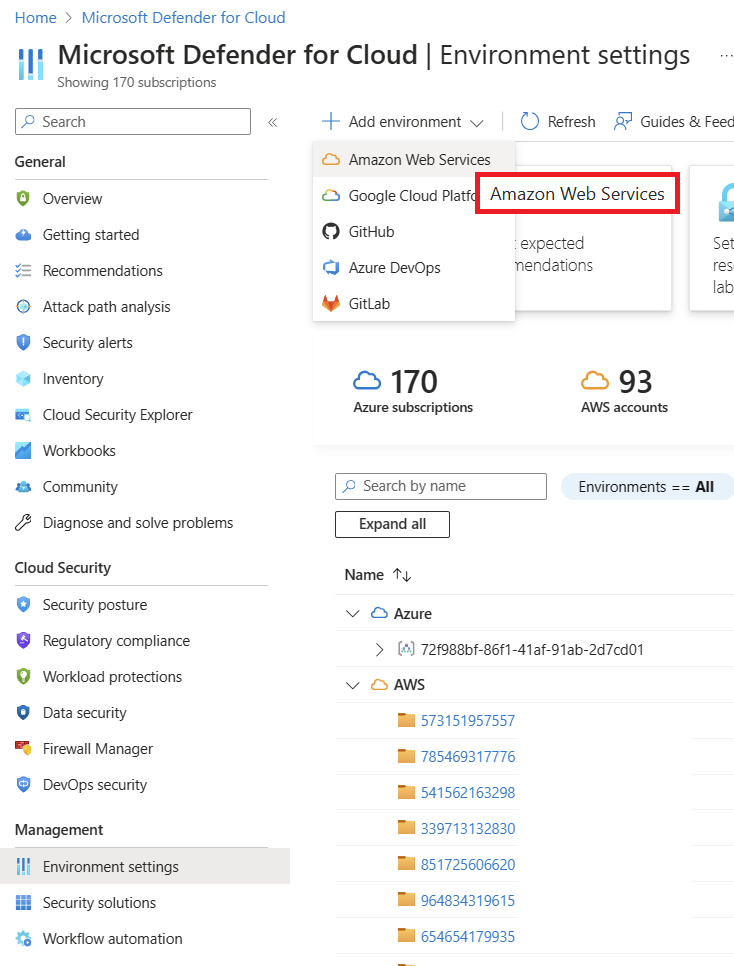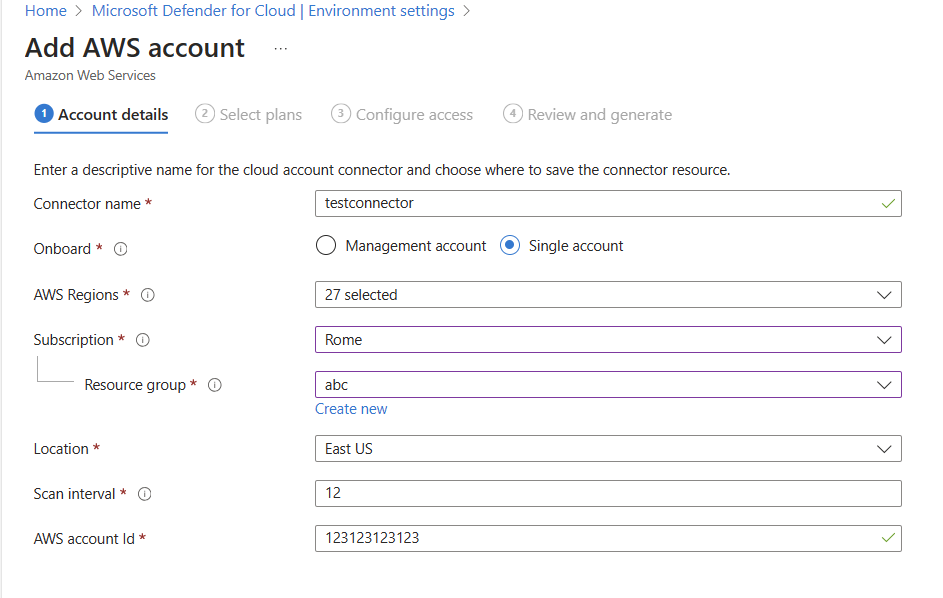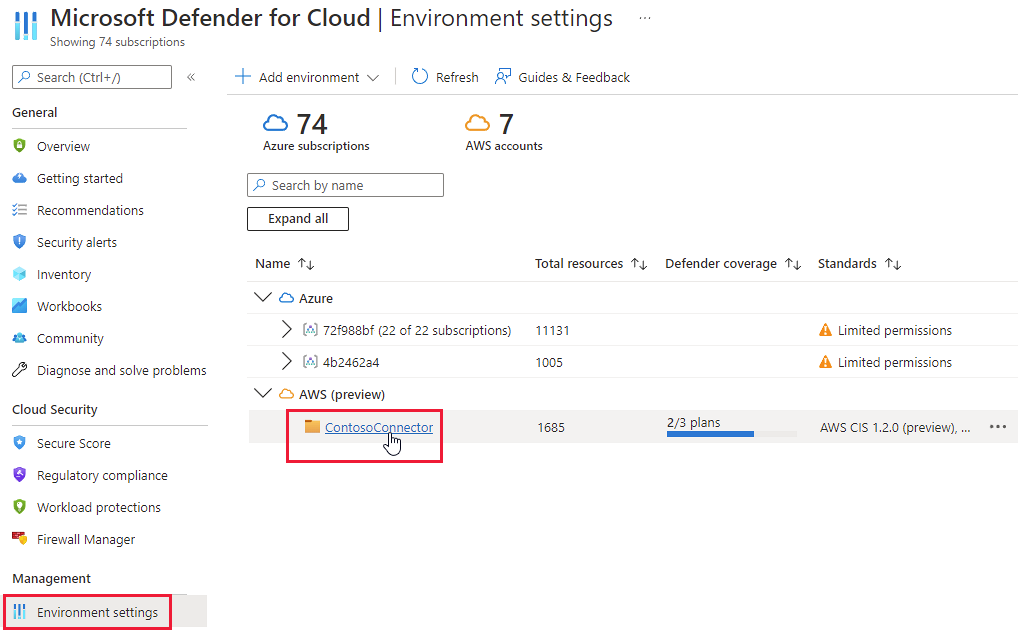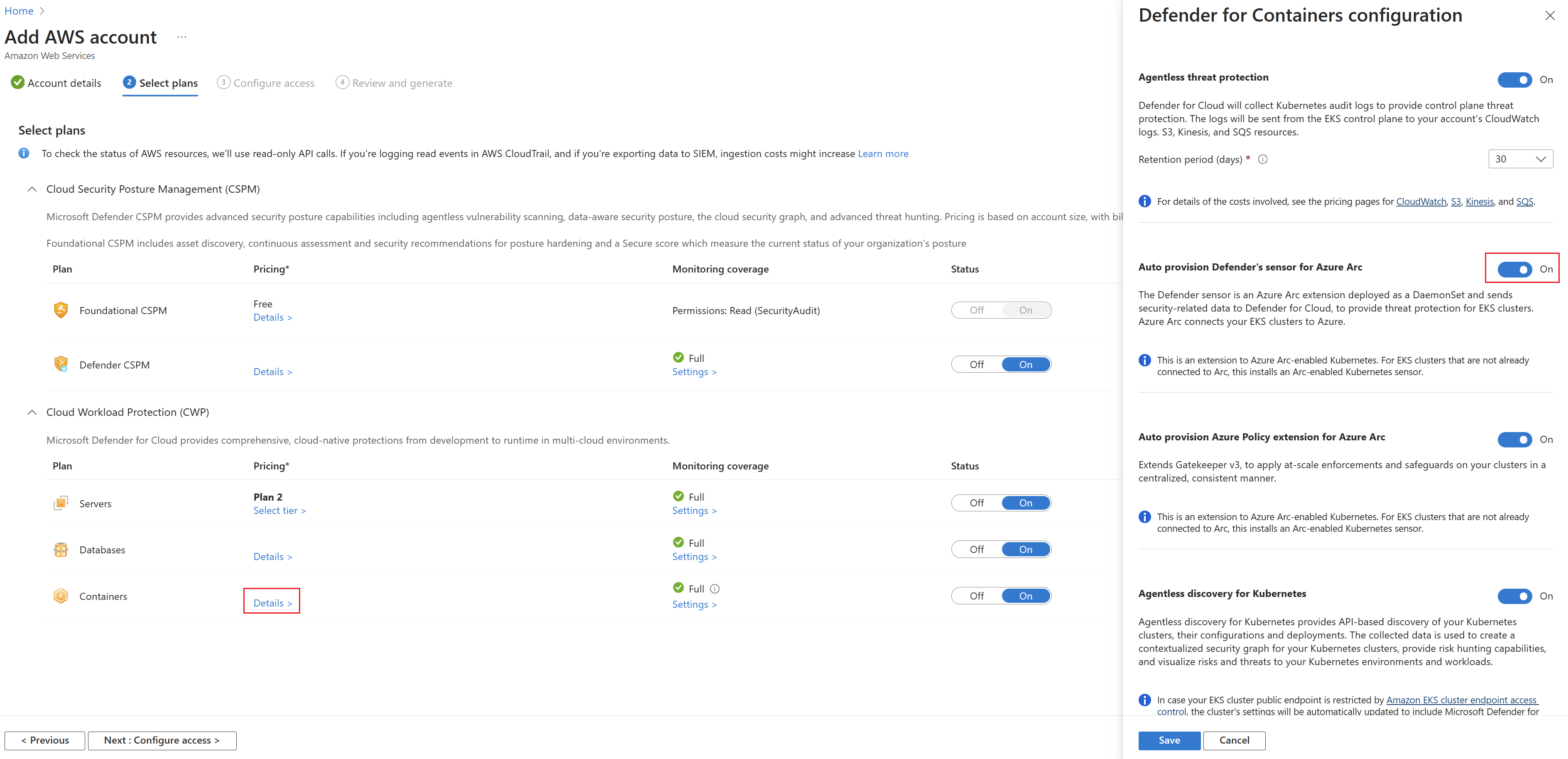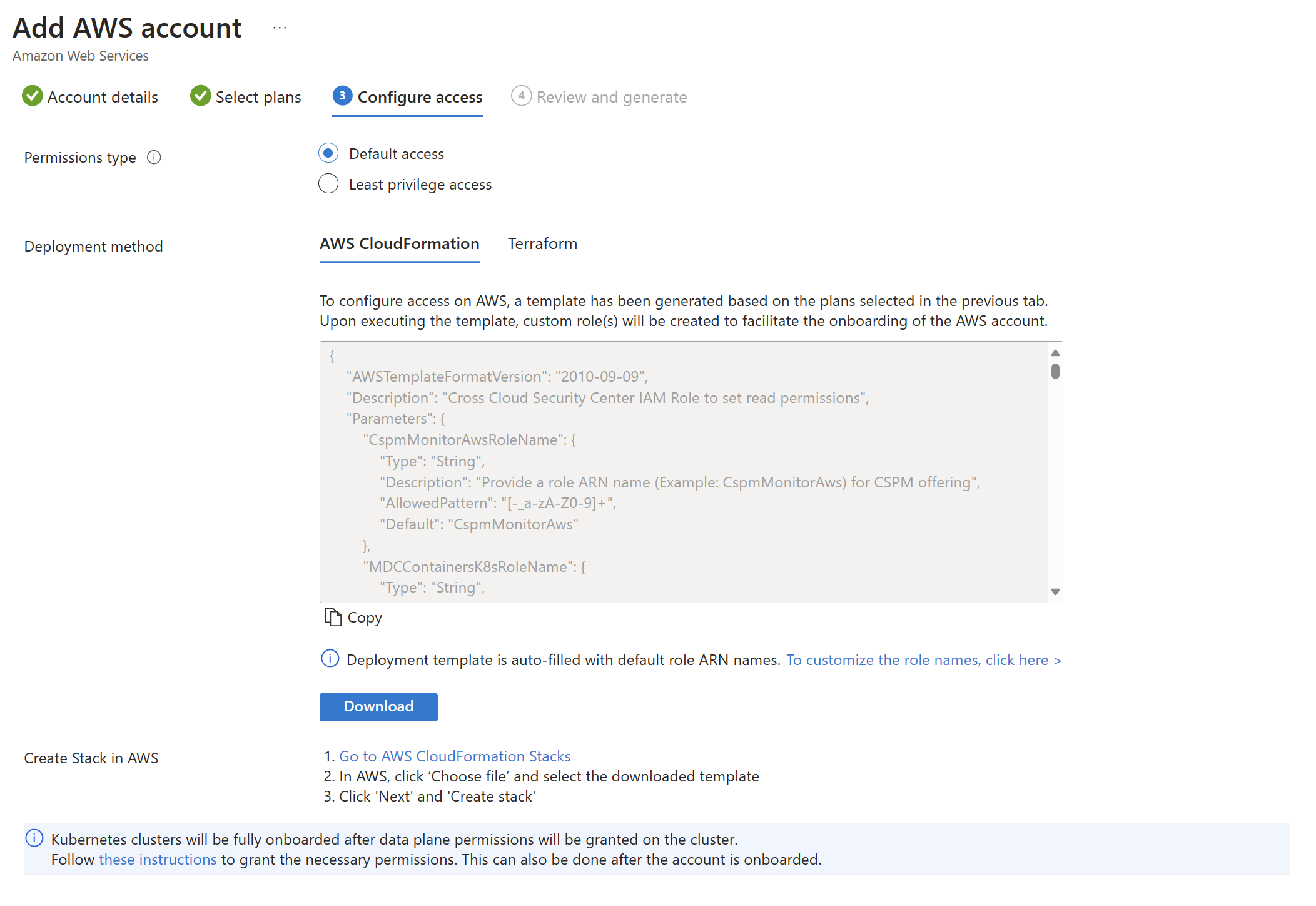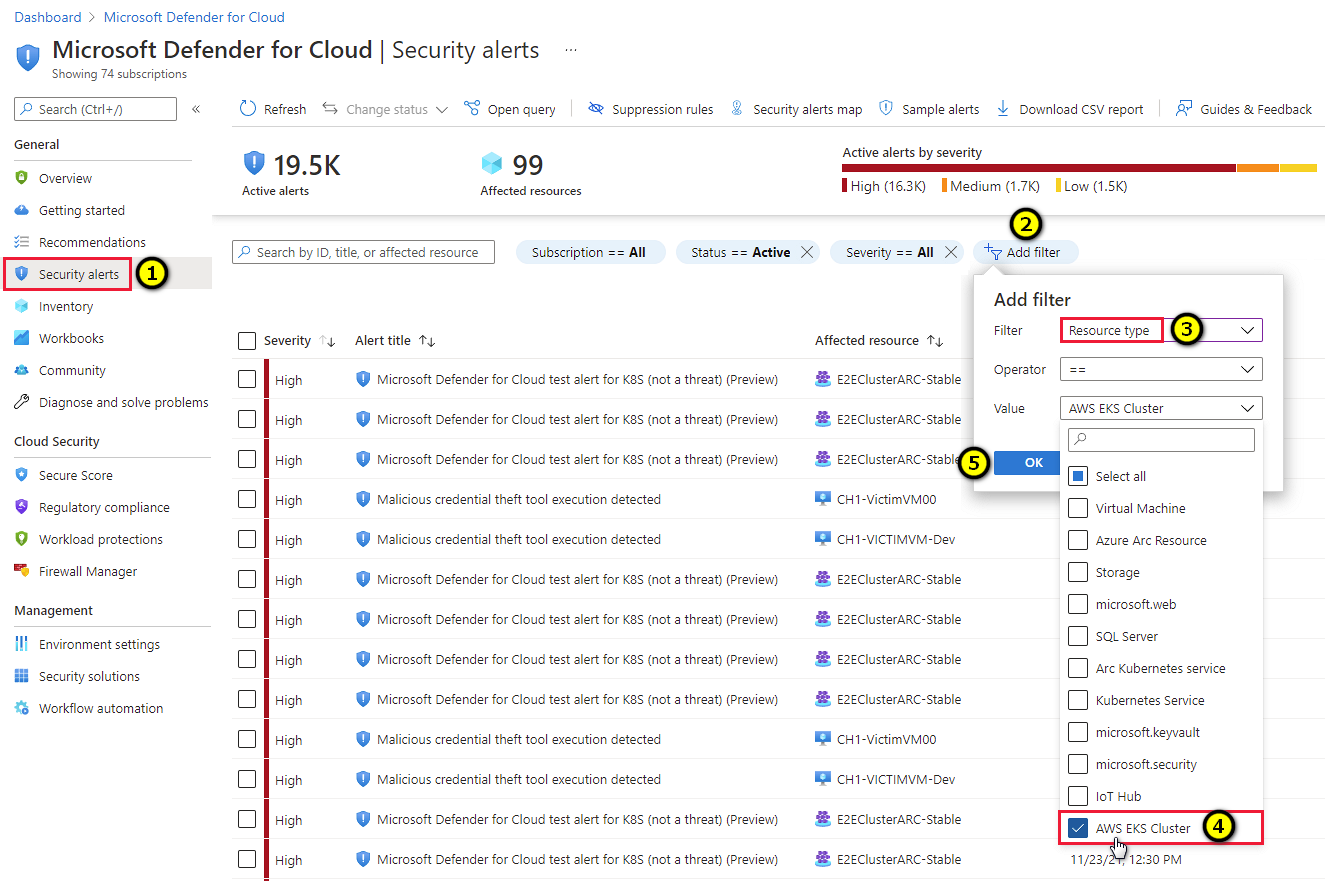Note
Access to this page requires authorization. You can try signing in or changing directories.
Access to this page requires authorization. You can try changing directories.
This article shows you how to enable Microsoft Defender for Containers on your Amazon EKS clusters through the Azure portal. You can choose to enable all security features at once for comprehensive protection, or selectively deploy specific components based on your requirements.
When to use this guide
Use this guide if you want to:
- Set up Defender for Containers on AWS for the first time
- Enable all security features for comprehensive protection
- Selectively deploy specific components
- Fix or add missing components to an existing deployment
- Deploy using a controlled, selective approach
- Exclude certain clusters from protection
Prerequisites
Network requirements
Validate that the following endpoints for public cloud deployments are configured for outbound access. Configuring them for outbound access helps ensure that the Defender sensor can connect to Microsoft Defender for Cloud to send security data and events.
Note
The Azure domains *.ods.opinsights.azure.com and *.oms.opinsights.azure.com no longer required for outbound access. For more information, see the deprecation announcement.
| Azure domain | Azure Government domain | Azure operated by 21Vianet domain | Port |
|---|---|---|---|
| *.cloud.defender.microsoft.com | N/A | N/A | 443 |
You also need to validate the Azure Arc-enabled Kubernetes network requirements.
AWS-specific requirements:
- AWS account with appropriate permissions
- Active EKS clusters (version 1.19+)
- Container images in Amazon ECR
- AWS CLI installed and configured
- Outbound HTTPS connectivity from EKS to Azure
Create AWS connector
Sign in to the Azure portal.
Go to Microsoft Defender for Cloud.
Select Environment settings from the left menu.
Select Add environment > Amazon Web Services.
Configure connector details
In the Account details section, enter:
- Account alias: A descriptive name for your AWS account
- AWS account ID: Your 12-digit AWS account identifier
- Resource group: Select or create a resource group
Select Next: Select plans.
Enable Defender for Containers features
In Select plans, toggle Containers to On.
Select Settings to access the plan configuration options.
Choose your deployment approach:
Option A: Enable all components (recommended)
For comprehensive protection, enable all features:
- Set all toggles to On
- This setting provides complete security coverage for your EKS environment
Option B: Enable specific components
Select only the components you need based on your requirements:
Configure the available components based on your chosen approach:
Agentless threat protection: Provides runtime protection to your cluster containers by sending Kubernetes audit logs to Microsoft Defender.
- Set the toggle to On to enable
- Configure the retention period for your audit logs
- Discovers all EKS clusters in your AWS account
Note
If you disable this configuration, control plane threat detection is disabled. Learn more about feature availability.
Kubernetes API access (Agentless discovery for Kubernetes): Sets permissions to allow API-based discovery of your Kubernetes clusters.
- Set the toggle to On to enable
- Provides inventory and security posture assessment
Registry access (Agentless container vulnerability assessment): Sets permissions to allow vulnerability assessment of images stored in ECR.
- Set the toggle to On to enable
- Scans container images for known vulnerabilities
Auto provision Defender's sensor for Azure Arc (Defender DaemonSet): Automatically deploys the Defender sensor on Arc-enabled clusters for runtime threat detection.
- Set the toggle to On to enable
- Provides real-time security alerts for workload protection
Tip
- For production environments, we recommend enabling all components.
- For testing or gradual rollout, start with specific components and add more later.
- Azure Policy for Kubernetes is automatically deployed with the Defender sensor.
Select Continue and Next: Configure access.
Set up AWS permissions
Follow the instructions on the Configure access page.
Download the CloudFormation template from the portal.
Deploy the CloudFormation stack in AWS:
- Open AWS CloudFormation console
- Create a new stack with the downloaded template
- Review and create the stack
After stack creation completes, copy the role ARN from the stack outputs.
Return to Azure portal and paste the role ARN.
Select Next: Review and create.
Review your configuration and select Create.
Deploy all components
Note
If you selected to enable all components in the previous section, follow all the steps in this section. If you chose specific components, complete only the steps relevant to your selected features.
Follow these steps to enable protection based on your configuration:
Grant control plane permissions
Required if you enabled: Agentless threat protection or Kubernetes API access
If you enabled Agentless discovery for Kubernetes, grant control plane permissions on the cluster by using one of these methods:
Option 1: Use the Python script
Run this Python script to add the Defender for Cloud role
MDCContainersAgentlessDiscoveryK8sRoletoaws-auth ConfigMapfor the EKS clusters you want to onboard.Option 2: Use eksctl
Grant each Amazon EKS cluster the
MDCContainersAgentlessDiscoveryK8sRolerole:eksctl create iamidentitymapping \ --cluster my-cluster \ --region region-code \ --arn arn:aws:iam::account:role/MDCContainersAgentlessDiscoveryK8sRole \ --group system:masters \ --no-duplicate-arnsFor more information, see Grant IAM users access to Kubernetes with EKS access entries in the Amazon EKS user guide.
Connect EKS clusters to Azure Arc
Required if you enabled: Auto provision Defender's sensor for Azure Arc
You need to install and run Azure Arc-enabled Kubernetes, the Defender sensor, and Azure Policy for Kubernetes on your EKS clusters. There's a dedicated Defender for Cloud recommendation to install these extensions:
Go to Microsoft Defender for Cloud > Recommendations.
Look for the recommendation: EKS clusters should have Microsoft Defender's extension for Azure Arc installed.
Follow the remediation steps provided by the recommendation:
Deploy the Defender sensor
Important
Deploying the Defender sensor using Helm: Unlike other options that are autoprovisioned and updated automatically, Helm lets you flexibly deploy the Defender sensor. This approach is especially useful in DevOps and infrastructure-as-code scenarios. With Helm, you can integrate deployment into CI/CD pipelines and control all sensor updates. You can also choose to receive preview and GA versions. For instructions on installing the Defender sensor using Helm, see Install Defender for Containers sensor using Helm.
Required if you enabled: Auto provision Defender's sensor for Azure Arc
After connecting your EKS clusters to Azure Arc, deploy the Defender sensor:
Go to Microsoft Defender for Cloud > Recommendations.
Look for recommendations about installing the Defender extension on Arc-enabled clusters.
Select the recommendation and follow the remediation steps.
The sensor provides runtime threat detection for your clusters.
Note
You can also deploy the Defender sensor by using Helm for more control over the deployment configuration. For Helm deployment instructions, see Deploy Defender sensor using Helm.
Configure ECR vulnerability scanning
Required if you enabled: Registry access
Go to your AWS connector settings.
Select Configure next to the Containers plan.
Verify Registry access is enabled.
Images pushed to ECR are automatically scanned within 24 hours.
Enable audit logging
Required if you enabled: Agentless threat protection
Enable audit logging for each EKS cluster:
# Enable audit logs
aws eks update-cluster-config \
--name <cluster-name> \
--logging '{"clusterLogging":[{"types":["audit","authenticator"],"enabled":true}]}'
View recommendations and alerts
To view the alerts and recommendations for your EKS clusters:
Go to the alerts, recommendations, or inventory pages.
Use the filters to filter by resource type AWS EKS Cluster.
Tip
You can simulate container alerts by following the instructions in this blog post.
Deploy specific components (optional)
If you initially chose to enable only certain components and now want to add more, or if you need to fix issues with existing deployments:
Add components to existing deployment
Go to Environment settings and select your AWS connector.
Select Defender plans > Settings next to Containers.
Enable additional toggles for the components you want to add:
- Agentless threat protection: For runtime protection
- Kubernetes API access: For cluster discovery
- Registry access: For ECR vulnerability scanning
- Auto provision Defender's sensor: For workload protection
Save your changes and follow the deployment steps for the newly enabled components.
Note
You can exclude a specific AWS cluster from automatic provisioning. For sensor deployment, apply the ms_defender_container_exclude_agents tag on the resource with the value true. For agentless deployment, apply the ms_defender_container_exclude_agentless tag on the resource with the value true.
Deploy Defender sensor to specific clusters
To deploy the sensor only to selected EKS clusters:
Connect specific clusters to Azure Arc (not all clusters).
Go to Recommendations and find "Arc-enabled Kubernetes clusters should have Defender extension installed".
Select only the clusters where you want the sensor.
Follow the remediation steps for selected clusters only.
Deploy components for existing clusters
If you have clusters with missing or failed components, follow these steps:
Check component status
Go to Inventory and filter by AWS resources.
Check each EKS cluster for:
- Arc connectivity status
- Defender extension status
- Policy extension status
Fix Arc connectivity issues
For clusters that show as disconnected:
Rerun the Arc connection script.
Verify network connectivity from the cluster to Azure.
Check Arc agent logs:
kubectl logs -n azure-arc -l app.kubernetes.io/component=cluster-agent
Fix sensor deployment issues
For clusters missing the Defender sensor:
Verify Arc connection is healthy.
Check for conflicting policies or admission controllers.
Deploy manually if needed: Use remediation from the recommendation.
Configure ECR scanning for specific registries
To scan only specific ECR registries:
In the connector configuration, enable Agentless container vulnerability assessment.
Use AWS IAM policies to limit scanner access to specific registries.
Tag registries to include or exclude from scanning.
Deploy Azure Policy extension selectively
To deploy policy assessment only to specific clusters:
After Arc connection, go to Policy > Definitions.
Search for "Configure Azure Policy extension on Arc-enabled Kubernetes".
Create an assignment scoped to specific resource groups or clusters.
Verify deployment:
kubectl get pods -n kube-system -l app=azure-policy
Configure audit logging for specific clusters
Enable audit logging selectively:
# For specific cluster
aws eks update-cluster-config \
--name <specific-cluster> \
--logging '{"clusterLogging":[{"types":["audit"],"enabled":true}]}'
Verify deployment
Check connector health
Go to Environment settings.
Select your AWS connector.
Verify:
- Status: Connected
- Last sync: Recent timestamp
- Discovered resources count
View discovered resources
Go to Inventory.
Filter by Environment = AWS.
Make sure you see:
- All EKS clusters (or only selected ones if deployed selectively)
- ECR registries
- Container images
Test security detection
Generate a test security alert:
# Connect to an EKS cluster
aws eks update-kubeconfig --name <cluster-name> --region <region>
# Trigger a test alert
kubectl run test-alert --image=nginx --rm -it --restart=Never -- sh -c "echo test > /etc/shadow"
Check for the alert in Defender for Cloud within 5 to 10 minutes.
Troubleshooting
Deployment issues
If components fail to deploy:
- Check Arc connection: Ensure clusters show as Connected
- Verify IAM role: Confirm the role has all required permissions
- Review network: Check outbound HTTPS connectivity
- Check quotas: Verify AWS service quotas aren't exceeded
Sensor pods not starting
# Check pod status
kubectl describe pods -n kube-system -l app=microsoft-defender
# Common issues:
# - Image pull errors: Check network connectivity
# - Permission denied: Verify RBAC settings
# - Resource constraints: Check node resources
Arc extension stuck
# Check extension status
az k8s-extension show \
--cluster-name <cluster-name> \
--resource-group <rg> \
--cluster-type connectedClusters \
--name microsoft.azuredefender.kubernetes
# If stuck, delete and recreate
az k8s-extension delete \
--cluster-name <cluster-name> \
--resource-group <rg> \
--cluster-type connectedClusters \
--name microsoft.azuredefender.kubernetes
ECR scanning not working
Verify the IAM role has ECR permissions.
Check if the scanner can access registries.
Ensure images are in supported regions.
Review scanner logs in Log Analytics workspace.
Common verification issues
- Missing resources: Wait 15-30 minutes for discovery.
- Partial coverage: Check excluded resources configuration.
- No alerts: Verify audit logging is enabled.
- Scan failures: Check ECR permissions and network access.
Best practices
- Start with non-production: Test on dev/test clusters first for selective deployment.
- Regular reviews: Check the dashboard weekly.
- Alert response: Investigate high-severity alerts promptly.
- Image hygiene: Scan and update base images regularly.
- Compliance: Address CIS benchmark failures.
- Access control: Review IAM roles and RBAC permissions.
- Document exclusions: Track why certain clusters are excluded in selective deployments.
- Deploy incrementally: When using selective deployment, add one component at a time.
- Monitor each step: Verify each component before proceeding to the next.
Clean up resources
To disable Defender for Containers, complete the following steps:
Go to your AWS connector.
Choose either:
- Turn Containers Off to disable the plan
- Delete the entire connector to remove all configurations
Remove AWS resources:
- Delete the CloudFormation stack
- Disconnect clusters from Arc
